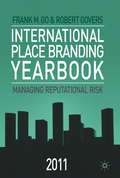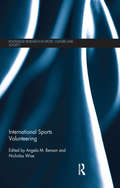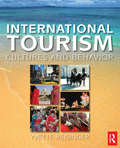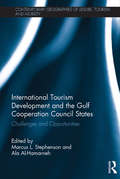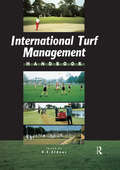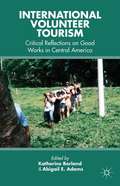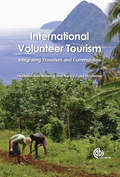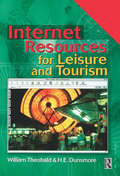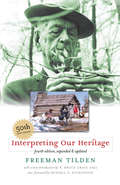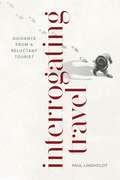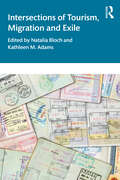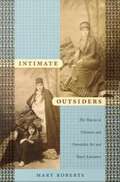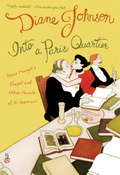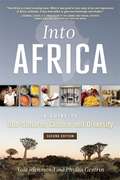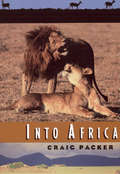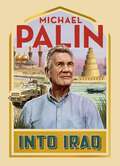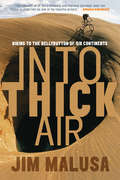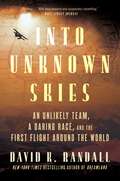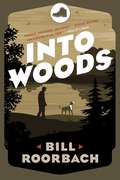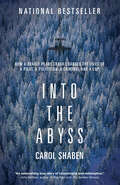- Table View
- List View
International Place Branding Yearbook 2011: Managing Reputational Risk
by Frank M. Go Robert GoversThe second annual volume of the International Place Branding Yearbook; this collection looks at the case for applying brand and marketing strategies and to the economic, social, political and cultural development of cities, towns and regions around the world to help them compete in the global, national and local markets.
International Retailing Plans and Strategies in Asia
by John Dawson Erdener Kaynak Jung-Hee LeeLearn the how, when, and why of entering Asian marketsRetailers entering Asia are faced with not only a consumer and retail culture very different from their own, but with a variety of cultures that vary greatly among countries within the continent. International Retailing Plans and Strategies in Asia examines the strategies of Western retailers entering into Asian markets and provides specific case examples showing why some companies have failed in Asia-as well as factors that helped others succeed. Important concepts for international retailers exploring Asian markets are clearly explained, and the material is particularly relevant to current WTO and UNCTAD debates about the globalization of retail markets. Helpful tables, charts, and illustrations make complex information easy to access and understand.International Retailing Plans and Strategies in Asia examines: how foreign investment influences domestic retail systems how strategies for entering European markets can be adapted and applied to various Asian markets the important practice of incorporating local cultural values into trading relationships in Asian markets the investment of Japanese retailers in China and the trend toward internationalization in Asia by Asian retailers the evolution of foreign investment in Korea-with a look at foreign firms&’ specific investment strategies issues of local competition and the need for foreign firms to adapt to local consumer cultures, particularly as analyzed in case studies of Metro Cash and Carry, Toys R Us, and Carrefour what understanding foreign markets means in terms of adaptation and success for retailers and wholesalersThe material in these pages will help to inform business decisions about how to (and how not to) enter foreign markets and whether or not it is proper for governments to intervene. The chapters in this book, originally presented as papers at a workshop held at Chung-Ang University in Seoul in November 2003, address issues of diversity in international retailing and distribution in Asia. International Retailing Plans and Strategies in Asia is designed to be essential reading for international marketing students, retail researchers, business managers, and policymakers, and to be a useful addition to university business school library collections.
International Sports Events: Impacts, Experiences and Identities (Advances in Tourism)
by Alan Fyall Richard ShipwayThis book offers new insight into International Sports Events (ISEs), examining the relationship between sport, tourism and events. It assesses sports events through the lens of both sports participants and spectators, based on three primary themes: impacts, experiences and identities. The first section of the book contributes to the future development of knowledge by analyzing the impact of sport events and their legacies from economic, environmental, social, sporting, political and cultural perspectives – an understanding of the impacts and potential legacies of sports events is fundamental to their future development. In the second section of the book, the focus moves from impact and legacy issues towards exploring consumer behaviour and participant experiences at a diverse selection of International Sports Events. The emphasis within this section is grounded within the tourism dimension of sports events. Section three of the book highlights the dominant role of identity at a diverse selection of sports events, and demonstrates how that identity is displayed whilst either watching or participating in sport and leisure. The book provides an international analysis drawing on emerging empirical research conducted across a diverse range of sport and leisure activities and contrasting locations. Linked to the three underlying themes of the book, a future research agenda for International Sports Events is provided which is centred on four key pillars: impact, identity, internationalization and interdisciplinary research. This timely book will be of interest to students, researchers and academics studying Event Management, Sport Management and Sport Tourism.
International Sports Volunteering (Routledge Research in Sport, Culture and Society)
by Nicholas Wise Angela M. BensonSport volunteering is becoming an increasingly popular motive for international travel. Many tourism organisations now advertise sport volunteering projects, with colleges and universities also offering students the opportunity to participate in similar projects abroad. This is the first book to bring together diverse and interdisciplinary insights into the development of the contemporary sport volunteering phenomenon. It addresses conceptual uncertainties and challenges emerging from the growing international sport volunteering market, and offers insight into its future directions, impact and sustainability. Drawing on both quantitative and qualitative methodologies, Part I examines volunteering in the context of international sporting events, while Part II evaluates volunteering initiatives related to sport development. Including case studies from Australia, Cameroon, Namibia, Norway, Russia, the UK, the US and Zambia, this substantial volume provides a truly international perspective on the changing roles of sport volunteering. Showcasing the latest research from across the globe, International Sports Volunteering is a valuable resource for any course on sport studies, sport event management, sport development, sport tourism, sport geography, the sociology of sport or leisure studies.
International Tourism
by Yvette Reisinger Frederic DimancheIn recent years there has been a considerable interest in the cultural aspects of tourism such as the impacts of culture on tourism planning, development, management, and marketing. However, the focus has been on material forms of culture such as arts, music, or crafts. The impacts of national culture on tourist behavior and travel decision-making have not been paid much attention. Only in the last two years have cross-cultural issues begun to generate significant interest among academics.An examination of cultural characteristics and differences is extremely important to the tourism industry because today’s tourism environment is becoming increasingly international. Information on the nature of the cultural differences between international tourists and locals is not readily available in tourism literature. The concept of culture is very complex and includes such abstract concepts as satisfaction, attitude and loyalty. International Tourism brings these concepts to the undergraduate student in tourism, as well as students in the related fields of marketing, management, international business, and cross-cultural communication. Designed as a textbook, it isorganized and presented in an integrated and relevant way for the benefit of a worldwide audience.
International Tourism Development and the Gulf Cooperation Council States: Challenges and Opportunities (Contemporary Geographies of Leisure, Tourism and Mobility)
by Marcus L. Stephenson Ala Al-HamarnehThis book examines the challenges facing the development of tourism in the six member states of the Gulf Cooperation Council (GCC): Bahrain, Kuwait, Oman, Qatar, Saudi Arabia and the United Arab Emirates (UAE). This region, which largely comprises the Arabian Peninsula, possesses some of the fastest growing economies in the world and is remarkably unique. It shares similar associations and affinities: tribal histories, royal kinship, political associations, Bedu cultural roots, Islamic heritage, rapid urbanization, oil wealth, rentier dynamics, state capitalist structures, migrant labour, economic diversification policies and institutional restructuring. Therefore, this volume takes the study of tourism away from its normative unit of analysis, where tourism in the region is being examined within the context of the Middle East and the wider Islamic and Arab world, towards an enquiry focusing on a specific geo-political territory and socially defined region. Although international tourism development in the region embodies a range of challenges, complexities and conflicts, which are deeply contextualized in this volume, the approach overall does not endorse the normative ‘Gulf bashing’ position that has predominated within the critical enquiries in the region. It presents a forward-looking and realistic assessment of international tourism development, examining development potentialities and constructive ways forward for GCC states and the region as a whole. This edited volume provides a real attempt to examine critically ways in which tourism and its development intersect with the socio-cultural, economic, political, environmental and industrial change that is taking place in the region. By doing so, the book provides a theoretically engaged analysis of the social transformations and discourses that shape our contemporary understanding of tourism development within the GCC region. Moreover, it deciphers tourism development’s role within the context of the GCC states undergoing rapid transformation, urbanization, ultra-modernization, internationalization and globalization. In addition to state-specific illustrations and destination case studies, the work provides insights into relatable themes associated with international tourism development in the region, such as tourism’s relationship with religion, heritage and identity, the environment and sustainability, mobility and cross-border movements, the transport industry, image production and destination branding, mega-development and political stability and instability. The book combines theory with diverse case study illustrations, drawing on disciplinary knowledge from such fields as sociology, political economy and social geography. This timely and original contribution is essential reading for students, researchers and academics in the field of tourism studies and related subject areas, along with those who have regional interests in Middle East studies, including Gulf and Arabian Peninsula studies.
International Turf Management
by David AldousMany leisure activities involve the use of turf as a surface. Grass surfaces on golf courses, bowling clubs, cricket pitches, racetracks, and parks all require maintenance by trained personnel. International Turf Management Handbook is written by a team of international experts. It covers all aspects of turf management and in particular* the selection and establishment of grass varieties* soils, irrigation and drainage* performance testing and playing qualities* issues relating to specific playing surfaces In its depth of coverage and detailed practical advice from around the world this comprehensive handbook is destined to become the standard reference work on the subject.
International Volunteer Tourism
by Katherine Borland Abigail E. AdamsDesigned to promote reflection and better practices among the prospective volunteers and organizers of travel-for-service experiences,International Volunteer Tourism provides a collection of narratives on short-term international volunteering in Central America written by North American organizers, student participants, and Central American partners. The authors explore lessons learned from specific international service interventions in Nicaragua, El Salvador, and Honduras, with some attention to Costa Rica and Guatemala. The collection provides a nuanced, contextualized, historically evolving portrait of the increasingly popular practice of "voluntourism" with an eye toward pushing that practice toward meaningful social change.
International Volunteer Tourism
by Stephen Wearing Nancy Gard McgeheeVolunteer tourism has increased in popularity and prevalence and is no longer considered only a small section of alternative tourism. It is now part of the mainstream tourism industry and tourism experience for many people. Concentrating on the experience of the volunteer tourist and the host community, this new book builds on the view of volunteer tourism as a positive and sustainable form of tourism to examine a broader spectrum of behaviours and experiences and consider critically where the volunteer tourist experience both compliments and collides with host communities, using multiple case studies.
International Volunteer Tourism: Integrating Travellers and Communities
by Stephen Wearing Nancy Gard McGeheeVolunteer tourism has increased in popularity and prevalence and is no longer considered only a small section of alternative tourism. It is now part of the mainstream tourism industry and tourism experience for many people. Concentrating on the experience of the volunteer tourist and the host community, this new book builds on the view of volunteer tourism as a positive and sustainable form of tourism to examine a broader spectrum of behaviours and experiences and consider critically where the volunteer tourist experience both compliments and collides with host communities, using multiple case studies.
Internet Resources for Leisure and Tourism
by William F. Theobald H. E. DunsmoreInternet Resources for Leisure and Tourism is designed to allow students, academics and practitioners within the leisure and tourism fields to get the very most out of the World Wide Web, helping them track down and fully exploit the most useful resources available. This book includes pointers on how to find and utilise, among other things: the latest economic statistics and demographics, information about government agencies and their programs, the content of universities' websites, up-to-the-minute statistics on visitor arrivals and departures, information on forthcoming meetings and conferences, and details of contents in periodicals.Features include: details of interesting sites for content, design and / or specific information notes emphasizing important information about a site shortcuts and easy-to-use methods for performing functions a wide variety of Internet topics - from how to find a provider to how to compress and decompress files that you download. The book is now updated and supported by a new companion website which provides the reader with regular updates about the latest online developments - thus continually keeping them up to speed in what is an exceptionally fast-moving medium.
Interpreting Our Heritage
by R. Bruce Craig Freeman TildenEvery year millions of Americans visit national parks and monuments, state and municipal parks, battlefields, historic houses, and museums. By means of guided walks and talks, tours, exhibits, and signs, visitors experience these areas through a very special kind of communication technique known as "interpretation." For fifty years, Freeman Tilden's Interpreting Our Heritage has been an indispensable sourcebook for those who are responsible for developing and delivering interpretive programs. This expanded and revised anniversary edition includes not only Tilden's classic work but also an entirely new selection of accompanying photographs, five additional essays by Tilden on the art and craft of interpretation, a new foreword by former National Park Service director Russell Dickenson, and an introduction by R. Bruce Craig that puts Tilden's writings into perspective for present and future generations. Whether the challenge is to make a prehistoric site come to life; to explain the geological basis behind a particular rock formation; to touch the hearts and minds of visitors to battlefields, historic homes, and sites; or to teach a child about the wonders of the natural world, Tilden's book, with its explanation of the famed "six principles" of interpretation, provides a guiding hand. For anyone interested in our natural and historic heritage--park volunteers and rangers, museum docents and educators, new and seasoned professional heritage interpreters, and those lovingly characterized by Tilden as "happy amateurs"--Interpreting Our Heritage and Tilden's later interpretive writings, included in this edition, collectively provide the essential foundation for bringing into focus the truths that lie beyond what the eye sees.
Interrogating Travel: Guidance from a Reluctant Tourist
by Paul LindholdtNever in human history has travel been so accessible to so many. But—amid an escalating climate crisis that threatens the homes of vulnerable people across the world—has the human cost of trekking the globe become too high? Paul Lindholdt links firsthand narratives with research about the travel trade, telling stories of his reluctant voyages while arguing that carbon-intensive trips abroad may be offset if adventurers come to know and love the landscapes closer to home. Tourism may be the planet’s largest industry, but Interrogating Travel advises readers to stay mindful of the consequences of their journeys, whether visiting local getaways or some of Earth’s most remote locations.
Intersections of Tourism, Migration, and Exile
by Kathleen M. Adams Natalia BlochThis book challenges the classic – and often tacit – compartmentalization of tourism, migration, and refugee studies by exploring the intersections of these forms of spatial mobility: each prompts distinctive images and moral reactions, yet they often intertwine, overlap, and influence one another. Tourism, migration, and exile evoke widely varying policies, diverse popular reactions, and contrasting imagery. What are the ramifications of these siloed conceptions for people on the move? To what extent do gender, class, ethnic, and racial global inequalities shape moral discourses surrounding people’s movements? This book presents 12 predominantly ethnographic case studies from around the world, and a pandemic-focused conclusion, that address these issues. In recounting and juxtaposing stories of refugees’ and migrants’ returns, marriage migrants, voluntourists, migrant retirees, migrant tourism workers and entrepreneurs, mobile investors and professionals, and refugees pursuing educational mobility, this book cultivates more nuanced insights into intersecting forms of mobility. Ultimately, this work promises to foster not only empathy but also greater resolve for forging trails toward mobility justice. This accessibly written volume will be essential to scholars and students in critical migration, tourism, and refugee studies, including anthropologists, sociologists, human geographers, and researchers in political science and cultural studies. The book will also be of interest to non-academic professionals and general readers interested in contemporary mobilities.
Intimate Outsiders: The Harem in Ottoman and Orientalist Art and Travel Literature
by Mary RobertsUntil now, the notion of a cross-cultural dialogue has not figured in the analysis of harem paintings, largely because the Western fantasy of the harem has been seen as the archetype for Western appropriation of the Orient. In Intimate Outsiders, the art historian Mary Roberts brings to light a body of harem imagery that was created through a dynamic process of cultural exchange. Roberts focuses on images produced by nineteenth-century European artists and writers who were granted access to harems in the urban centers of Istanbul and Cairo. As invited guests, these Europeans were "intimate outsiders" within the women's quarters of elite Ottoman households. At the same time, elite Ottoman women were offered intimate access to European culture through their contact with these foreign travelers. Roberts draws on a range of sources, including paintings, photographs, and travelogues discovered in archives in Britain, Turkey, Egypt, and Denmark. She rethinks the influential harem works of the realist painter John Frederick Lewis, a British artist living in Cairo during the 1840s, whose works were granted an authoritative status by his British public despite the actual limits of his insider knowledge. Unlike Lewis, British women were able to visit Ottoman harems, and from the mid-nineteenth century on they did so in droves. Writing about their experiences in published travelogues, they undermined the idea that harems were the subject only of male fantasies. The elite Ottoman women who orchestrated these visits often challenged their guests' misapprehensions about harem life, and a number of them exercised power as patrons, commissioning portraits from European artists. Their roles as art patrons defy the Western idea of the harem woman as passive odalisque.
Into A Paris Quartier: Reine Margot's Chapel & Other Haunts of St.-Germain
by Diane JohnsonModern St.-Germain is lively and prosperous, and fifty years ago its heady mix of jazz and existentialism defined urbane cool, but Johnson takes a longer view. "Beside the shades of Jean-Paul Sartre and Edith Piaf", she writes, "there is another crowd of resident ghosts, misty figures in plumed hats whose fortunes and passions were enacted among these beautiful, imposing buildings". From her kitchen window, she looks out on a chapel begun by Reine Margot, wife of Henri IV; nearby streets are haunted by the shades of two sinister cardinals, Mazarin and Richelieu, as well as four famed queens and at least five kings. Delacroix, Corot, Ingres, David, and Manet all lived in St.-Germain; Oscar Wilde died there; and everybody who was anybody visited sooner or later.
Into Africa: A Guide To Sub-saharan Culture And Diversity (Interact Ser.)
by Yale Richmond Phyllis GestrinAcross the globe, Africa is seen as the final frontier for economic development and has experienced renewed attention from both Western and Eastern nations, particularly in the last decade. The U. S. , India, China and parts of Europe have all increased foreign direct investment in Africa, and yet the complexity and diversity of this vast continent pose risks and challenges for those investments. For more than a decade, Into Africa has provided valuable advice to those who are interested in traveling to, living in or working in sub-Saharan Africa'businesspeople, human rights and development workers, diplomats, academics and trainers'and anyone else who seeks a better understanding of the cultural characteristics of this dynamic part of the world. With depth and sensitivity, Into Africa examines the effects of community, ethnicity and language on doing business and establishing professional and personal relationships in African countries. The book explores regional differences, offers detailed guidelines for conducting training programs in Africa and examines issues that reflect the complex relationships involved. This new and expanded edition of Into Africa brings a fresh view on sub-Saharan Africa, showing how the nations of Africa have adapted to Western ways while retaining their cultural traditions and diversity. Authors Yale Richmond and Phyllis Gestrin explore contemporary Africa in great depth, discussing increased trade with the U. S. and Europe, the role of politics and business, changes in mass communication and the continuing threat of HIV/AIDS. A thorough, lively and carefully researched book, Into Africa is the perfect companion for anyone wishing to gain a more rounded perception of Africa and its diverse cultures.
Into Africa: With a New Postscript
by Craig PackerCraig Packer takes us into Africa for a journey of fifty-two days in the fall of 1991. But this is more than a tour of magnificent animals in an exotic, faraway place. A field biologist since 1972, Packer began his work studying primates at Gombe and then the lions of the Serengeti and the Ngorongoro Crater with his wife and colleague Anne Pusey. Here, he introduces us to the real world of fieldwork—initiating assistants to lion research in the Serengeti, helping a doctoral student collect data, collaborating with Jane Goodall on primate research. As in the works of George Schaller and Cynthia Moss, Packer transports us to life in the field. He is addicted to this land—to the beauty of a male lion striding across the Serengeti plains, to the calls of a baboon troop through the rain forests of Gombe—and to understanding the animals that inhabit it. Through his vivid narration, we feel the dust and the bumps of the Arusha Road, smell the rosemary in the air at lunchtime on a Serengeti verandah, and hear the lyrics of the Grateful Dead playing off bootlegged tapes. Into Africa also explores the social lives of the animals and the threats to their survival. Packer grapples with questions he has passionately tried to answer for more than two decades. Why do female lions raise their young in crèches? Why do male baboons move from troop to troop while male chimps band together? How can humans and animals continue to coexist in a world of diminishing resources? Immediate demands—logistical nightmares, political upheavals, physical exhaustion—yield to the larger inescapable issues of the interdependence of the land, the animals, and the people who inhabit it.
Into Iraq
by Michael PalinIn March 2022, Michael Palin travelled the length of the River Tigris through Iraq to get a sense of what life is like in a region of the world that once formed the cradle of civilisation, but that in recent times has witnessed turmoil and appalling bloodshed. In the journal he kept during his trip he describes the war-ravaged city of Mosul and the children he encounters growing up amid its ruins. He contemplates the graffiti-strewn ruins of Saddam Hussein's former palaces, and he notes the constant presence of armed guards. But there are patches of light amid the dark: boisterous New Year celebrations in Akre, the friendliness of generals and colonels at 'Checkpoint Cheerful', and public poetry readings in Baghdad. People getting on with their lives.At the same time, Michael charts the course of one of the great rivers of the world, showing how the water that gave life to such ancient settlements as Babylon and Ur is now becoming a scarce and hotly contested resource. And he considers the role that Iraq's other great natural resource - oil - plays in both providing wealth and threatening political stability.Illustrated throughout with colour photographs taken on the trip, and permeated with his warmth and humour, this is a vivid and varied portrait of a complex country.
Into Thick Air: Biking to the Bellybutton of Six Continents
by Jim MalusaWith plenty of sunscreen and a cold beer swaddled in his sleeping bag, writer and botanist Jim Malusa bicycled alone to the lowest point on each of six continents, a six-year series of "anti-expeditions" to the "anti-summits." His journeys took him to Lake Eyre in the arid heart of Australia, along Moses' route to the Dead Sea, and from Moscow to the Caspian Sea. He pedaled across the Andes to Patagonia, around tiny Djibouti in the Horn of Africa, and from Tucson to Death Valley. With a scientist's eye, he vividly observes local landscapes and creatures. As a lone man, he is overfed by grandmothers, courted by ladies of the night in Volgograd, invited into a mosque by Africa's most feared tribe, chased by sandstorms and hurricanes - yet Malusa keeps riding. His reward: the deep silence of the world's great depressions. A large-hearted narrative of what happens when a friendly, perceptive American puts himself at the mercy of strange landscapes and their denizens, Into Thick Air presents one of the most talented new voices in contemporary travel writing.
Into Unknown Skies: An Unlikely Team, a Daring Race, and the First Flight Around the World
by David K. Randall“Thrilling . . . With deep research and suspenseful storytelling, Mr. Randall reminds us that America’s pre-eminence in the aviation industry was never assured and that it took a race of unlikely heroes to bring the dream of world flight to the public imagination.”—Wall Street Journal“David K. Randall has conjured the first air race to circumnavigate the globe in all its death-defying glory, featuring a cast of unlikely heroes who had the right stuff before anyone knew what that was.” — Mitchell Zuckoff, New York Times bestselling author of Lost in Shangri-La and 13 Hours“Thrilling reading...an account filled with unexpected layers of intrigue. Recommend Into Unknown Skies to Erik Larson fans.” —BooklistThe unbelievable history of the 1924 race to circumnavigate the globe for the first time by air, a nail-biting contest that pitted underdog US pilots against their better-funded European rivals, created technology that changed aviation, and convinced America that its future was in the sky. In the early 1920s, America’s faith in aviation was in shambles. Twenty years after the Wright Brothers’ first flight, most Americans believed airplanes were for delivering the mail or performing daredevil stunts in front of crowds. The dream of commercial air travel remained just that. Even the American military was a skeptic—rather than pay to bring its planes back from Europe following World War I, the War Department chose to burn most of them instead. All that changed with a single race in 1924. It was not just any race, though—it was a race to become the first to circle the globe in an airplane, pitting a team of underdog American pilots against the best aviators in the world from England, Italy, Portugal, France, and Argentina. Rooted in the same daring spirit that pushed early twentieth-century explorers to attempt crossings of the Antarctic ice or locate the source of the Nile, this race was an adventure unlike anything the world had seen before. The obstacles were daunting—from experimental planes, to dangerous landings in uncharted territory, to the simple navigational gauges that could lead pilots hundreds of miles off course. Failure seemed all but guaranteed—the suspense less about who would win than how many would perish for the honor of being the first.Now on the race’s centennial, award-winning author David K. Randall tells the story of this riveting, long-forgotten race. Through larger-than-life characters, treacherous landings, disease, and ultimately triumph, Into Unknown Skies demonstrates how one race returned America to aviation greatness. A story of underdog teammates, bold exploration, and American ingenuity, Into Unknown Skies is an untold adventure tale showing the power of flight to bring the world together.
Into Woods
by Bill RoorbachInto Woods is an exuberant, profound, and often wonderfully funny account of ten years in the life of author Bill Roorbach. A paean to nature, love, family, and place, it begins with his honeymoon on a wine farm in France's Loire Valley and closes with the birth of his daughter and he and his wife's return to their beloved Maine. These essays blend journalism, memoir, personal narrative, nature writing, cultural criticism, and insight into a flowing narrative of place, a meditation on being and belonging, love and death, wonder and foreboding.
Into a Paris Quartier
by Diane JohnsonAcclaimed author Diane Johnson brings to life the legendary St. Germain-des-Prs quarter of Paris--her adoptive home for many years--with riveting stories that explain its continued mystique in the heart of the world's most alluring city.
Into the Abyss: How a Deadly Plane Crash Changed the Lives of a Pilot, a Politician, a Criminal and a Cop
by Carol ShabenOn an icy night in October 1984, a Piper Navajo commuter plane carrying 9 passengers crashed in the remote wilderness of northern Alberta, killing 6 people. Four survived: the rookie pilot, a prominent politician, a cop, and the criminal he was escorting to face charges. Despite the poor weather, Erik Vogel, the 24-year-old pilot, was under intense pressure to fly--a situation not uncommon to pilots working for small airlines. Overworked and exhausted, he feared losing his job if he refused to fly. Larry Shaben, the author's father and Canada's first Muslim Cabinet Minister, was commuting home after a busy week at the Alberta Legislature. After Paul Archambault, a drifter wanted on an outstanding warrant, boarded the plane, rookie Constable Scott Deschamps decided, against RCMP regulations, to remove his handcuffs--a decision that profoundly impacted the men's survival. As they fought through the night to stay alive, the dividing lines of power, wealth and status were erased and each man was forced to confront the precious and limited nature of his existence. The survivors forged unlikely friendships and through them found strength and courage to rebuild their lives. Into the Abyss is a powerful narrative that combines in-depth reporting with sympathy and grace to explore how a single, tragic event can upset our assumptions and become a catalyst for transformation.
